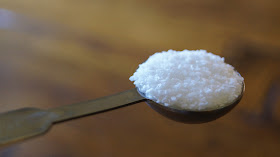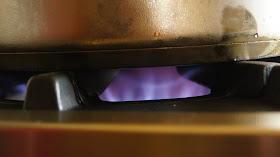The carved wooden bread tray has been calling my name for years. Its simple smooth sides with a shape that hugs the finest of baguettes. The warmth of its timber so inviting. Must ... not....succumb to its pricey beauty. I kept telling myself the $5.00 bread basket I already have has dutifully served my needs for years.
WAIT A MINUTE...a sale! Let me check....
Could it be? Are my eyes deceiving me? The handsome treasure is on sale. Sold along with a few other needed items! Sorry little $5 bread basket. You'll find a good life with another family.
To begin with, the tray really didn't cost much ($25). A purchase of this nature seemed like a little luxury I was having a hard time justifying. But put that baby on sale by 25% all the justifying in the world was easy to come by. For example I could use it as a lovely centerpiece in addition to being a mere bread tray. Just saying....
By waiting for the right price point (in my head), my now wooden bread tray was chosen with love.
Can't the same be said for the tray's original purpose? A freshly homemade baguette nesting in the tray only further symbolizes the rewards of exercising patience.
Anyone can go buy a ready made baguette these days. To really appreciate a good loaf as I readily do, I attack making bread myself. You may remember my love affair on this subject, if not click here. Rolling up my sleeves this last weekend, I let time do its job and made what I hope is the first of many homemade breads which will have a brief residence in my beloved tray.
Ingredients
3 cups all-purpose flour
1 cup whole-wheat flour
1 1/4 cups water
1 tsp dry yeast or 1/2 oz fresh yeast
2 tsp honey
2 Tbsp sesame seeds
2 Tbsp pumpkin seeds
2 Tbsp flax seeds
2 Tbsp sunflower seeds
2 Tbsp rolled oats
2 tsp salt
First, soak the sesame, pumpkin, flax, rolled oats and sunflower seeds in warm water for 20 minutes. Then drain.
Mix the two flours with the water, yeast and honey for 2 minutes in a mixer using the bread hook attachment. Let rest for 20 minutes.
Add two tablespoons salt and the soaked seeds to the flour mixture. Mix for 5 minutes.
Cover and let rest for 15 minutes at a minimum temperature of 72 degrees F.
Turn out onto a floured work surface. Shape into an 8" loaf by first flattening the dough into a rectangle about 8x5 inches, then rolling it up toward the 8" side.
Remove the cover and place in a pre-heated oven of 425 degrees, baking 25 minutes. If using a convection oven, lower heat to 400 degrees and bake 20 minutes or until the crust is golden brown.
Remove immediately from pan and let rest for 15 minutes before enjoying.
What a satisfying reward in overcoming a few of life's impatient moments.
WAIT A MINUTE...a sale! Let me check....
Could it be? Are my eyes deceiving me? The handsome treasure is on sale. Sold along with a few other needed items! Sorry little $5 bread basket. You'll find a good life with another family.
To begin with, the tray really didn't cost much ($25). A purchase of this nature seemed like a little luxury I was having a hard time justifying. But put that baby on sale by 25% all the justifying in the world was easy to come by. For example I could use it as a lovely centerpiece in addition to being a mere bread tray. Just saying....
By waiting for the right price point (in my head), my now wooden bread tray was chosen with love.
Can't the same be said for the tray's original purpose? A freshly homemade baguette nesting in the tray only further symbolizes the rewards of exercising patience.
Anyone can go buy a ready made baguette these days. To really appreciate a good loaf as I readily do, I attack making bread myself. You may remember my love affair on this subject, if not click here. Rolling up my sleeves this last weekend, I let time do its job and made what I hope is the first of many homemade breads which will have a brief residence in my beloved tray.
Marc's Homemade 5 Grain Bread
Chef Marc Bauer
From the Dropping Acid: The Reflux Diet Cookbook & Cure
Ingredients
3 cups all-purpose flour
1 cup whole-wheat flour
1 1/4 cups water
1 tsp dry yeast or 1/2 oz fresh yeast
2 tsp honey
2 Tbsp sesame seeds
2 Tbsp pumpkin seeds
2 Tbsp flax seeds
2 Tbsp sunflower seeds
2 Tbsp rolled oats
2 tsp salt
First, soak the sesame, pumpkin, flax, rolled oats and sunflower seeds in warm water for 20 minutes. Then drain.
Mix the two flours with the water, yeast and honey for 2 minutes in a mixer using the bread hook attachment. Let rest for 20 minutes.
Add two tablespoons salt and the soaked seeds to the flour mixture. Mix for 5 minutes.
Turn out onto a floured work surface. Shape into an 8" loaf by first flattening the dough into a rectangle about 8x5 inches, then rolling it up toward the 8" side.
Place in a 8" loaf pan or free-style it on a jelly roll pan that has been oiled or use a silpat. Cover and keep warm, about 72-77 degrees F, until the dough doubles in volume. I let it sit for another good hour.Remove the cover and place in a pre-heated oven of 425 degrees, baking 25 minutes. If using a convection oven, lower heat to 400 degrees and bake 20 minutes or until the crust is golden brown.
Remove immediately from pan and let rest for 15 minutes before enjoying.
What a satisfying reward in overcoming a few of life's impatient moments.























